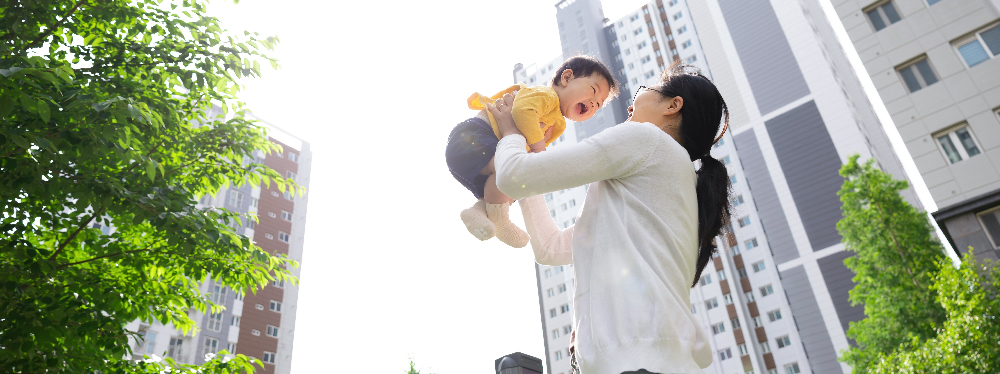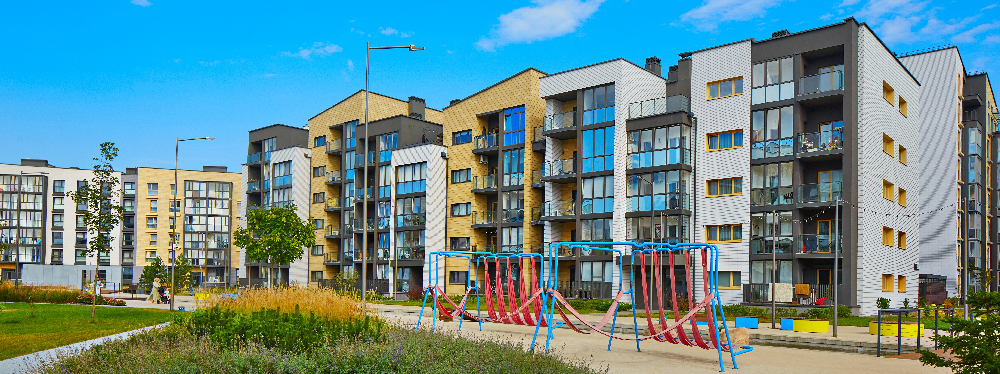An apartment complex is a building or group of buildings with separate units for residents, typically rented out by the owner. It is a distinct type of dwelling from single-family homes that provide shared property services, community involvement, and maintenance. However, its limitations include common area rules and proximity to other units or neighbours.
While looking for a 3 BHK flat in Mumbai and Thane, understanding the finer points of apartment complex living can significantly influence your experience and level of satisfaction in your chosen home.

Apartment Complex Meaning
An apartment complex is a collection of buildings that accommodate multiple families or individuals, each in its unit but all within the same compound. It is usually owned and operated by a single organisation and has facilities readily accessible to all the structures.
Definition and Overview
Apartments consist of several units, from small single-room studios to larger ones with several rooms, collectively called multi-room flats. They are typified by common plants, particularly parking facilities, glazed ground floors and foyers, lifts, and leisure amenities.
Therefore, the apartment complex’s implication goes beyond the presence of concrete facilities; it refers to a collective living area where residents are entitled to certain privileges and obligations.
Distinctions from Other Housing Types
In contrast to homes or townhouses, where an entire wall separates each living unit, apartment buildings provide a denser type of housing structure where units can be side by side sharing a wall. They are distinct from condominiums in terms of ownership, as in many apartment buildings, residents pay their rent instead of owning the space.
Furthermore, apartments offer features and facilities generally unavailable for other dwellings, such as a maintenance department, a security feature, and social or leisure facilities for the tenants.
The Structure of an Apartment Complex
-
Common Layouts and Designs
The population is diverse, and the apartments are designed differently to meet the requirements of the dwellers as much as possible. These can be studio, one, two, three and sometimes four-plus bedroom units, although these are relatively scarce.
Layouts are generally optimised with spacious living areas, well-equipped kitchens, and separate bedding spaces. Some contemporary complexes also comprise balconies or patios to expand the living area.
-
Number of Units and Building Configuration
Apartment buildings are of different sizes and can consist of dozens of residences or large-scale complexes housing hundreds of families. They may comprise low-rise structures of three to four floors, mid-rise structures of five to twelve, or high-rise towers of over twelve.
Some complexes have different kinds of buildings at a single site, making it versatile to live in many ways.
Key Amenities in Modern Apartment Complexes
-
Security Features (CCTV, Guards, Gated Entry)
Contemporary apartments provide security for residents through the installation of numerous security measures. These usually involve residential area surveillance by installing closed-circuit television cameras in common areas, security personnel staffing the compound, and entry doors equipped with keys or codes.
Other amenities include intercoms and security measures such as secure parking areas within the complex.
-
Recreation Facilities (Gyms, Pools, Play Areas)
For convenient exercise and leisure, some apartment complexes have laid down facilities for a more active lifestyle within the compound. Well-built and stocked health facilities meet the needs of the athletic heart, while swimming pools afford a lovely respite.
Safe and separate playgrounds so that kids and toddlers have their own facilities, including appropriate and safe play structures. Some complexes may also feature one or the other, be it sports courts or jogging tracks.
-
Community Spaces (Clubhouses, Event Rooms)
The common areas for interactions among people are common features of the modern apartment complex. Most clubhouses have lounge areas and entertainment systems at the heart of the clubhouses. Event rooms are designed for celebrations, business conferences, and other occasions. A few complexes offer rooftop terraces or gardens to mingle with.
Family-Friendly Features
-
Proximity to Schools and Parks
Apartment complexes targeted towards families are situated near good schools and parks. This closeness to school minimises children’s commute while their school is near recreational soil.
Indeed, some of these complexes provide priority admission or transport services to other nearby schools to make these complexes more attractive for those with school-going children.
-
Child-Friendly Amenities (Playgrounds, Childcare Services):
Many contemporary apartment buildings provide spaces that are mainly designed for children. A few complexes take it further by having child care centres or child minding facilities after school to help working families.
All these amenities improve the quality of life for those families that live in the building and promote the development of a supportive community of people with children.
Read Also: Luxury Flats & Apartments in Thane
Pros and Cons of Living in an Apartment Complex
Pros
- Convenience: Apartment complexes provide convenient living. Various services are within the compound, so there is less stress when it comes to living maintenance services. Conveniences such as gyms, laundry, and shops inside the compound and, at times, within the building itself are more convenient.
- Cost-Effectiveness: It is important to note that dividing the current price of utilities and standard maintenance among all owners of the many units in the building eliminates a large part of the cost of owning an apartment.
- Security: Apartment complexes contain specific features, such as gates, security guards, and CCTV, that may be lacking in individual homes.
Cons
- Space Limitations: Due to the limited space available to property owners, housing units such as apartments are more compact than single-family homes. This can cause problems with storage, particularly in prominent places, especially when large furniture is needed or extensive decorating is required.
- Lack of Privacy: Residents of such apartments have less privacy because the flats are connected. The walls may be thicker than in a typical residential building, but the walls are shared between two units. The floors and ceilings of the units are also shared, and common areas are also part of the apartment complex.
Read Also: Luxury Modern Bathrooms in 2024
Choosing the Right Apartment Complex
Factors to Consider
- Location: Assess how close your family would be to work, daycare, schools, bus stops, and other basic infrastructure. Consider whether the building’s location is safe, if there will be much noise, or if it is close to a park or shop.
- Amenities: Determine which amenities are crucial to your life, such as a gym, parking space, or pet rules. In this case, determine whether the facilities provided are worth the extra coin in the rent.
- Budget: Consider the fundamental rent, utilities, car parking expenses, and other fees for utilising the related services. Consider the possibility of gaining the most out of included services instead of paying them separately.
How to Evaluate a Prospective Complex
- It is advisable to visit it in the morning, mid-morning, afternoon, and evening to see how noisy or lively the community is.
- Interview residents to get their feedback on their stay and their contentment.
- Read the lease agreement and understand the rules and regulations concerning guests, pets and repairs.
- The cleanliness of the unit and common areas, as well as the status of maintenance, should also be checked.
- Collect information about the management company and its interactions with the tenants.
Though apartment complexes may have difficulties, such as limited space, the advantages of affordable solutions and social returns exceed the disadvantages. When selecting an apartment complex, it is vital to choose the area, the facilities, and the price you wish to pay to get an apartment that meets your requirements.
Are you looking for a perfect apartment complex? Discover the residential properties in South Mumbai. Get in touch with us to learn more about these residential properties and find the home of your desire in one of the city’s desirable locations.
FAQs
- How much does an apartment in Mumbai cost?
As of August 2024, the average price of multistorey apartments in Mumbai is ₹3.71 crore, with a median price of ₹2.39 crore. However, the prices depend on the region of the property as well as the type of real estate.
- What is the difference between an apartment and an apartment complex?
An apartment is also called a flat and denotes a single dwelling. On the other hand, an apartment complex is a whole compound on which several buildings or towers are built.
- What is the difference between a flat complex and an apartment complex?
The only significant difference that can be identified between a flat complex and an apartment complex is negligible. In British English, the term ‘flat’ is equivalent to ‘apartment’ in American English.
- What are the different types of apartment buildings?
Apartment buildings are of different forms; these are differentiated based on size, structure, and facilities.
- High-rise: These massive structures may have more than ten stories. They commonly have lifts and are mostly situated in business districts.
- Mid-rise: Mid-rises are smaller than high-rises but bigger than walk-ups. They range from four to nine floors and might possess elevators, provided the building is raised to specific heights.
- Walk-ups: Walk-ups are apartment buildings typically two to four stories high and do not contain a lift. Residents use stairs to gain access to the apartments. They are more prevalent in areas with older structures or districts with mostly residences.
- What are the components of an apartment complex?
The various components of an apartment complex are:
- Individual Units
- Common Areas
- Amenities
- Retail and Commercial Spaces
- Should I rent or own an apartment?
People have to balance owning and hiring a place to live in. Purchasing guarantees safety, and people take pride in being homeowners, whereas renting has the advantages of mobility and lower costs.






